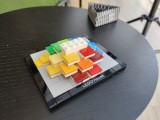vivo X Flip review

Great camera setup as clamshells go
The X Flip has one of the best-specced camera setups on a small foldable, better in one way or another than previous efforts in this form factor. A large-sensor main camera is joined by an ultrawide unit with AF - the last (only) time we got such such a combo was on the Huawei P50 Pocket. There's obviously the inherent benefit of the cover screen that enables extra rear-camera functionality that non-foldables can't easily get.

The primary camera on the back uses the Sony IMX 866 sensor and hardware apps report it as 866v, so it could be a vivo-specific variant. Technically a 1/1.49" 54MP imager in an unusual 1.43:1 aspect (8,768x6,144px), it's being treated as a 50MP unit here (8,192x6,144px). It's an RGBW/Quad Bayer design and it outputs 12.5MP images by default, binning four 1.0µm pixels into one. A relatively wide 23mm-equivalent lens with an f/1.8 aperture is in front of it, and it's a stabilized one.
The ultrawide camera employs the IMX 663, which we've seen on a number of Xperias for selfie or telephoto use, and it's no stranger to older vivos too, including the current X90 Pro (ultrawide there). The sensor has a 1/2.93" optical format and 1.22µm pixels, 12 million of them. The 16mm-equivalent lens has an f/2.2 aperture and features autofocus, giving you more creative opportunities.
The selfie camera is based on the 32MP Samsung S5KGD2 sensor - a 1/2.8" format with 0.8µm pixels and a Tetrapixel color filter. The sensor sits behind a 24mm f/2.45 lens, the focus is fixed.

The Origin OS camera app is essentially the same as the Funtouch one and if you've seen a recent vivo (or an iQOO), things should be very famliar. Of course there are some extra bits here that deal with the cover screen implementation, and we'll get to those in a bit.
The basics are straightforward. There's zoom selector with 0.6x, 1x and 2x steps. Accessing the Macro mode is done from the flower icon next to the settings cog icon.
The main modes are arranged in a carousel formation, and you can switch between them by swiping or tapping on one of the visible modes. The More tab lists the rest of the modes, and from there, you can also customize the modes you have available in the viewfinder.
The Pro mode gives you all the freedom to adjust focus distance, white balance, shutter speed, ISO and exposure. You can do so on the primary and ultrawide cameras. There's an 'i' button where you can get helpful information explaining all of the options in case you are just getting into photography. Shooting in RAW is also an option.
There's a tiny button in the top left corner that enables the cover screen preview or, when you're in 'selfie' mode, moves the entire camera interface on the outer display. If you're just using the outer display for letting your subjects get a live preview, you can give them one of two modes - a cropped up version, or the dual-preview one below that shows both the full capture area and a zoomed view of the center of the frame.

The cover screen offers most of the important functionality, albeit limiting the availablemodes to Photo, Video, and Portrait. Filters remain available too, and here the three additional options for shutter release (touch, palm, and voice) may come in handier. The eyebrow icon lets you hide a lot of the buttons to minimize clutter on the small-ish display.
An important setting is found behind the cog wheel - the one for aspect ratio. The viewfinder gives you a true preview - so if you're looking at a full-screen image on the viewfinder, you'll end up with that shot in the gallery. That's a heavily-cropped version of the image the sensor is capable of capturing, however, since the screen is at a 90-degree angle to the sensor - the display's longer side coincides with the sensor's shorter side. Thankfully, you can switch to a pillarboxed preview, which will get you the full image the sensor can see.
Daylight photo quality
Daylight photos out of the X Flip's main camera are very good. Highly-detailed and noise free, they're also fairly reasonable in terms of texture rendition - not the most natural, but not extremely overprocessed. Colors can be a bit weird at times, with a tendency to warm up the greens (which are also pretty liberally saturated), while there's greenish tinge in the whites and grays. It wasn't universal occurrence, but it wasn't a one-off either. Dynamic range is excellent, no complaints there.












Daylight samples, main camera (1x)
You could tone down the greenery (and colors overall, but mostly the greenery) if you shoot in the Zeiss mode. Other than the more reserved color saturation, we wouldn't say there are differences between the two modes.












Daylight samples, main camera (1x), Zeiss mode
The 50MP mode does resolve a smidge more detail, more easily quantifiable in the studio test charts than in the real world.








Daylight samples, main camera (1x), 50MP
Essentially the same in detail size per pixel as the 50MP mode, the 2x zoom mode does manage to produce images that look a bit sharper with better defined detail. Overall, these are great at fit to screen magnification and decent at 1:1.






Daylight samples, main camera (2x zoom)
The ultrawide camera doesn't disappoint either, treating you to reasonably well detailed images. It's a close match to the main camera in global parameters, so you'll be getting great dynamic range and mostly the same colors - with some of those occasional imperfections in white balance, too. There was some desaturation observed in slightly dimmer-lit indoor shots, however, like the Vespa, or the brick masonry, for example.












Daylight samples, ultrawide camera (0.6x)
Low-light photo quality
The X Flip applies Night mode processing by default. You can sometimes tell by firing a bunch of shots in rapid succession and one of the photos may end up without the frame-stacking treatment. In real-life scenarios, however, the auto Night mode action is very dependable. One small caveat is that you can't turn it off. The dedicated Night mode displays a countdown timer next to the shutter release while Photo mode does its thing more incognito, but on the main camera in particular we didn't notice meaningful differences between the results obtained in the two modes.
Main camera
The main camera captures excellent night-time shots. The X Flip adopts that more dramatic approach to low-light photography with more aggressive shadow brightening and that's more easily likeable that a supposedly more true-to-life rendition. Highlight preservation is also quite strong, so point light sources get rescued more often than not. All that isn't at the expense of detail loss, either - there's none of that watercolor effect we used to associate with such more zealous Night mode implementations. Color saturation doesn't suffer either and we had no issues with the auto white balance.








Low-light samples, main camera (1x)
Here's how these same scenes look in the standalone night mode. Do tell us if you spot a pattern of differences, because we couldn't.








Low-light samples, main camera (1x), Night mode
Main camera, 2x zoom
At 2x zoom, we did encounter some missteps in Photo mode, with Night mode having a tendency to be more dependable. In both cases, the phone was prone to hunting for focus, though, so it's worth keeping that in mind. If you avoid that, you can expect very good 2x shots, with all of the main camera's global goodness, and adequate detail levels.




Low-light samples, main camera (2x zoom)




Low-light samples, main camera (2x zoom), Night mode
Ultrawide camera
The ultrawide captures very good low-light photos in Photo mode. Again, those exhibit tell-tale signs of Night mode action - preserved highlights and liberally boosted shadows. Colors look great too. On a pixel level, there is some softness and noise and but neither is worse than what other clamshells can offer. In fact, we'd say these are the best low-light ultrawide photos from a small foldable - it may not be an all too high bar to clear, but it's something.








Low-light samples, ultrawide camera (0.6x)
Night mode can give you a touch more light and, consequently, a bit more detail and color in the shadows. It's not a huge difference, but it can be helpful in darker scenes.








Low-light samples, ultrawide camera (0.6x), Night mode
Once you're done with the real world samples, head over to our Photo compare tool to see how the vivo X Flip stacks up against the competition.


vivo X Flip against the Oppo Find N2 Flip and the Galaxy Z Flip4 in our Photo compare tool
Selfies
Selfies are a rather vast subject on the X Flip that we'll try to summarize as much as possible without leaving out anything important. Prepare for a few rows of the same shots - same, but different.
Main camera, UI on main display
There are three main flavors of selfies. For starters, there are those you take with the cover screen enabled for preview with the fully functioning interface on the main screen - technically those aren't selfies - since that's the intended for taking pictures of other people while letting them see themselves on the cover screen. But that's a technicality - you can take selfies this way just fine.
In this state you can take regular photos at all magnifications of the the rear cameras - 0.6 on the ultrawide, and 1x and 2x on the main camera. You can also use the Portrait mode, at 1x and 2x.
The 1x shots are great, with pleasing, life-like skin tones. Portrait mode offers excellent subject detection and believable blur levels, at both the 1x and 2x zoom levels. Naturally, the 2x setting is less appealing on a pixel level, but it offers a much improved perspective for head-and-shoulders framing and looks just fine at fit to screen.




Selfie samples, main camera, Photo mode




Selfie samples, main camera, Portrait mode, 1x




Selfie samples, main camera, Portrait mode, 2x
Main camera, UI on cover display
You can also switch to selfie mode, and tap the icon for moving the interface on the cover screen. You options will change in this state - there will be no 2x zoom level, whether for regular photos or portrait mode ones. You can pinch to zoom out to the ultrawide's 0.6x zoom level, and there will also be a Portrait mode for that one too (there's no 0.6x Portrait mode otherwise).
Another peculiarity is that you can't really have a basic background blur in this mode - you have to pick one of the 'Zeiss'-branded ones. That's why the portrait mode shots at 1x will be different between this state and the previous one. There's also the matter of the 20 or so minutes between shooting these and the previous sets of images, but you can treat it as another data point with our rapidly changing weather and all.
Your shooting options and end results will be the same whether you have the phone open, or flipped closed - as long as you have the camera controls on the cover screen.




Selfie samples, main camera, Selfie mode




Selfie samples, main camera, Selfie portrait mode
Selfies with an ultrawide camera with autofocus and a life preview - isn't that the dream? You can do weird angles and silly faces to your heart's content and your face will always be sharp. Just be careful to space these out in your feed, because they can get old quickly. One small complaint we have with these shots is that they're a little bit anemic with the color rendition - both skin tones and overall color have more pop in the other modes and sub modes.








Selfie samples, ultrawide camera, Selfie mode
We chose to shoot our ultrawide selfies in this state, because we also get to do ultrawde portraits - you don't often get to do ultrawide portraits. Admittedly, they do look a little odd, since you aren't conditioned to expect that much background blur from a lens this wide. But if you put the phone closer to your mug and you play around with the different blur simulations, you might get some rather unique shots with the X Flip.




Selfie samples, ultrawide camera, Selfie portrait mode
Internal camera
Last, and very much least, there's the internal camera - the conventional selfie camera, so to speak. These come out at the nominal 32MP and are actually very good as far as selfie cameras go. It's possibly one of the best implementations of 32MP selfie camera with excellent vibrant colors and wide dynamic range, plus some very good detail. Its portraits are top-notch too.
There's no autofocus here, however, and great as the shots may be for a selfie camera, the ability to shoot with the higher-quality, large-sensor, autofocus-having rear units relegates this internal shooter to video calls, we reckon.




Selfie samples, internal camera, Photo mode




Selfie samples, internal camera, Portrait mode
Video recording
The X Flip records video up to 4K60 with its primary camera, while the ultrawide is limited to 4K30 (and it doesn't do 60fps even in 1080p). The selfie camera, meanwhile, maxes out at 1080p30, which is coincidentally the only mode you get when using the main camera with the cover screen for framing - that's seems like an unnecessary limitation. There's another one too - the ultrawide camera can't be used for video on the cover display.
The rear cameras get stabilization in all resolution/frame rate combos, so at least there's that. But, to make matters even worse for selfie video capture, there's no stabilization available for the inner camera. It gets worse still - there's no stabilization on the main camera when recording video in selfie mode on the cover screen. What?
The standard choice of h.264 and h.265 codecs is available, with the less space-efficient but more wide compatible h.264 being the default option. Bit rates in 4K30 vary between 30Mbps and 48Mbps depending on the scene, while 4K60 is in the 48Mbps to 63Mbps range; audio is recorded in stereo, at 128kbps.
When t comes to detail, main camera footage in 4K is good at 30fps and actually better at 60fps - there's some softness when examining 30fps clips from up close that isn't there at the higher refresh rate. 30fps isn't bad, it's just not as sharp as 60fps.
Colors are likeable with a well judged saturation level but we're seeing a hint of a warm shift. The harsh midday light of our test scene produces quite a contrasty result and we'd prefer to have a little boost in the shadows, but it's okay as is, as well.
At 2x zoom, videos have that distinct upscaled look when examined from up close. They're usable, just not particularly great.
Things look even more contrasty on the ultrawide, and shadows get even darker. The auto white balance has given a faint yellowish cast to the road as well - at least the two cameras are fairly consistent in this regard. Detail is very good for an ultrawide in this class, so that's a win.
In low light, the main camera exposes very well and captures quite respectable videos. Detail is very good, dynamic range is excellent for the conditions with particularly well developed shadows, haloing in the highlights is decently well controlled.
The ultrawide isn't as keen on working at night, capturing darker clips that are soft and noisy.
Stabilization is mostly excellent on the X Flip. Both the main camera and the ultrawide iron out walking shake proficiently and don't suffer from any focus hunting. Pans are smooth with no jolts at the beginning or end, and it's only the gentlest of floating when pointing the phone in one direction that prevents us from calling the X Flip's results perfect.
Here's a glimpse of how the vivo X Flip compares to rivals in our Video compare tool. Head over there for the complete picture.


vivo X Flip against the Oppo Find N2 Flip and the Galaxy Z Flip4 in our Video compare tool
Reader comments
- niro56
- 12 Jun 2023
- xpA
"Please let us know if you spot a pattern of differences in night mode.." Of course, in the 5th low light pic, across the street, on the board titled "140 years of the capital", where Jesus dude is there, plus the one next to it...
- AnonD-1101735
- 10 Jun 2023
- n2N
https://m.gsmarena.com/samsung_galaxy_z_flip4-review-2467p4.php - Flip 4 https://m.gsmarena.com/vivo_x_flip-review-2576p4.php - X flip











